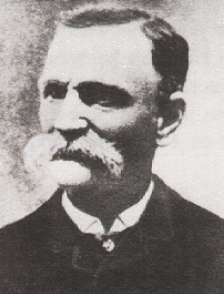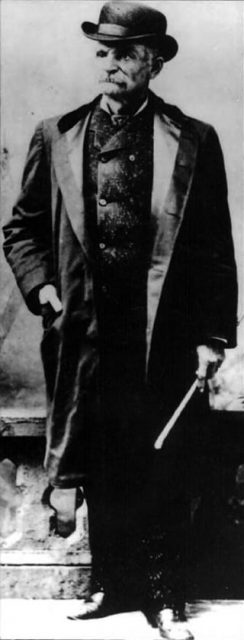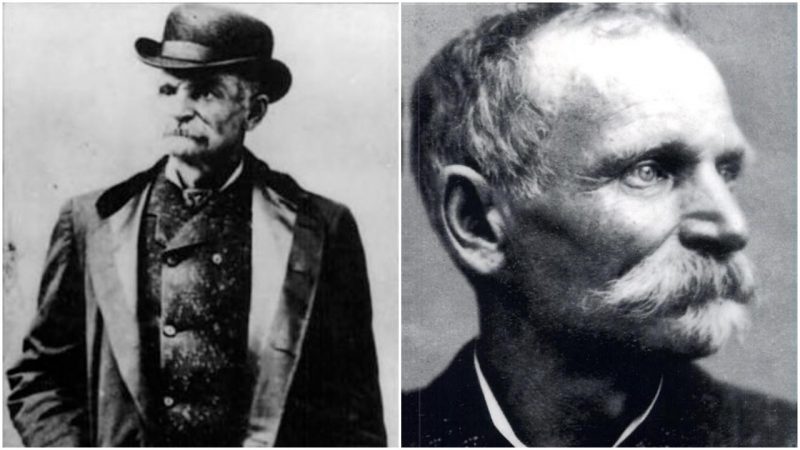It took nearly a decade for authorities to catch the infamous Western stagecoach robber Charles Earl Boles, alias Black Bart. That particular stretch of years proved to be more than fruitful for the mysterious bandit, who held up and robbed at least 28 Wells Fargo stages all by himself, earning a reputation as the most famous outlaw in the history of Northern California.
Black Bart was not the kind of illiterate and violent Wild West robber you’ve seen depicted in Western movies. On the contrary, his unparalleled style, sophistication, and politeness while robbing stagecoaches made him a most improbable robber. He was, believe it or not, considered a gentleman by most of the people who witnessed him doing what he knew best–robbing Wells Fargo stages.
However, before Black Bart became infamous from coast to coast, he was better known as Charles Boles and appeared to be nothing more than an ordinary adventurer from New York who, like many others, took part in the California Gold Rush during the early 1850s. He returned home in 1852 but soon went back to California, where he continued mining for two additional years before he went to Illinois and married Mary Elizabeth Johnson, with whom he had four children. Boles joined the Union Army in 1862 and took part in the Civil War, fighting in numerous battles.

He spent the next several years with his family, farming in Illinois, but decided to hit the road again in search of gold. Not much is known about his life during the following period, but a letter addressed to his wife tells us how an unpleasant incident with some Wells Fargo agents changed his life forever. No one knows exactly what happened on that fateful day but one thing is for sure, Boles vowed revenge against them, which apparently led him to a life of crime and turned him into one of the most notorious stagecoach robbers in Northern California.
Boles settled in San Francisco, where he went by the name of Charles Bolton. Between robberies he lived the life of a socialite, telling his rich friends that he owned a mine. The polite mine owner lived at Webb’s Hotel, wore the finest clothes, and dined at the best restaurants in San Francisco. All in all, this man was a clear representation of what a cultured, cosmopolitan man of the world should look like, except that he was a stagecoach robber.
He robbed his first stagecoach in Calaveras County on July 26, 1875. He was neither the first nor the last man to rob a stagecoach in Northern California, but what made him unique was the fact that, unlike other robbers, he was courteous and didn’t use any foul language, for which he soon became known as the gentleman bandit.

According to most accounts, the mysterious bandit was terrified of horses so always operated on foot, and never once fired his rusty old shotgun. He used the same method for every Wells Fargo stagecoach he robbed. He would patiently wait at a point of the road where the driver would be forced to slow down and he would then step out from behind the bushes in front of the stage, pointing a double-barreled shotgun at the driver and asking for the express box and the mailbags. It is said that he was only interested in these items and never robbed the passengers or the drivers of the stages.
Old Wild West Slang
The gentleman bandit committed numerous other robberies of Wells Fargo stagecoaches, but it was his fourth robbery in Sonoma County that made him popularly known as Black Bart. It was August 3, 1877, when a man who wore a flour sack with two eyeholes cut in, emerged out of nowhere and aimed a shotgun at the driver of a Wells Fargo stagecoach, politely asking him to throw down the strongbox. It was his money or his life. The driver chose his life and was free to go.
Because of the flour sack Boles wore, the driver couldn’t provide the best description when talking to the local detectives, but when they arrived at the place where the robbery occurred, they found a rather unusual clue. The robber had left a hilarious poem. It read:
“I’ve labored long and hard for bread,
For honor, and for riches,
But on my corns too long you’ve tread,
You fine-haired sons of bitches.”
– Black Bart, the PO 8.

Although some claim that Black Bart left poems every time he robbed a stage, in fact, he left only one more poem after his fifth hold-up. It read:
“Here I lay me down to sleep
To wait the coming morrow,
Perhaps success, perhaps defeat,
And everlasting sorrow.
Let come what will, I’ll try it on,
My condition can’t be worse;
And if there’s money in that box
‘Tis munny in my purse.”
– Black Bart, the PO 8.
It is believed that he had been inspired to take this particular pseudonym from a fictional character of an adventure story, The Case of Summerfield, published by American author William Henry Rhodes. A stagecoach robber named Black Bart is the main character of that particular story.
From what we’ve read so far, we can conclude that Bart was perhaps better at robbing stagecoaches than writing poems. Nonetheless, after robbing 28 Wells Fargo stages, the infamous Black Bart was finally captured and put behind bars, where he spent the next four years of his life.
After his release from prison in 1888, Black Bart simply disappeared and was never heard of again. Of course, as always, people’s imagination produced several more legends featuring Black Bart and over the years many people claimed to be the infamous bandit, but all of them were easily discredited. What happened to Charles Earl Boles, alias Black Bart, after his release from prison remains a mystery to date.
